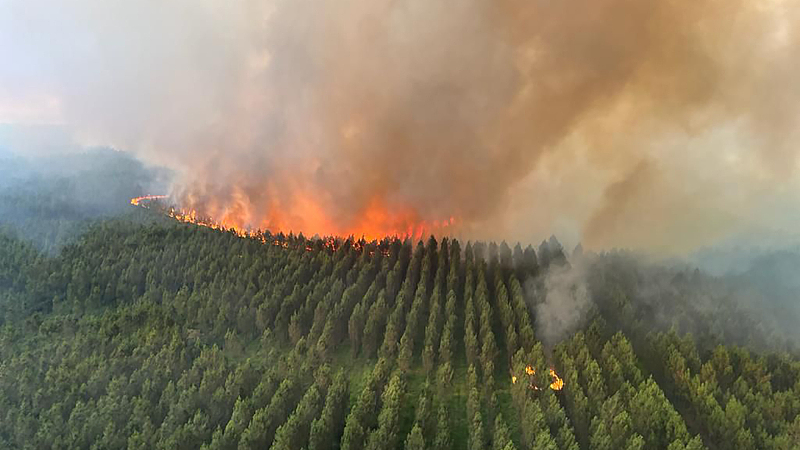
A wildfire near Landiras, southwestern France, July 14, 2022. /CFP
A wildfire near Landiras, southwestern France, July 14, 2022. /CFP
Editor's note: Aditi Hazra, an assistant professor at Harvard Medical School, is a cancer genomics researcher and humanitarian with training as an EMT and experience in refugee health. The article reflects the author's opinion, and not necessarily the views of CGTN.
When natural disasters force people to pack a bag and flee to safety, important items are often forgotten. Following California's 2007 wildfire season, it was estimated that "at least one family member per household left prescription medication behind during evacuation." Likewise, when Hurricane Harvey threatened to flood my own mother's Texas home in August 2017, she forgot to grab her medication in her rush to escape the storm's path – even though she was normally meticulous when packing for a trip.
With climate change contributing to the increased severity and frequency of such disasters, preventing interruptions in health care and meeting displaced people's unmet health needs will become an increasingly urgent task. We already know that extreme weather drives migration and statelessness, displacing 21.5 million people per year – 41 people per minute. Hurricanes, cyclones, floods, and wildfires regularly disrupt access to preventative services (such as routine cancer screening), mental-health services, and treatments for chronic diseases. Owing both to a severe drought and civil war, many Syrian refugees lost access to health care and were later found to be suffering from chronic diseases such as cancer, hypertension, and diabetes.
Climate-driven disasters pose both direct and indirect threats to the continuity of health care. According to a 2019 study in the Journal of General Internal Medicine, the 10-year survival rate of breast cancer patients whose treatment was directly interrupted by Hurricane Katrina was markedly worse than that of a control group.
Likewise, indirect exposures to chemicals, water- and airborne pathogens, and particulate air pollution from natural disasters are known to increase the risk of cancer. During Hurricane Harvey, for example, chemical plants and oil refineries were flooded, releasing cancer-causing substances into the surrounding environment. And researchers warn that currently inert chemicals like the insecticide lindane may become carcinogenic as the planet warms.
Wildfires pose similar threats, not only by destroying homes and health-care facilities but also by churning out harmful ambient particulate matter that increases the risk of death from lung, breast, and liver cancers. Heart attacks, strokes, and respiratory conditions such as asthma and chronic obstructive pulmonary disease often follow in the wake of the flames. New research, conducted over the course of 20 years, shows that people living within 50 kilometers (31 miles) of wildfires in Canada had a 10 percent higher risk of incident brain tumors and a 4.9 percent increased risk of incident lung cancer compared to people living farther away.

A woman walks out of a flooded subway amidst heavy rain in Mumbai, India, July 5, 2022. /CFP
A woman walks out of a flooded subway amidst heavy rain in Mumbai, India, July 5, 2022. /CFP
While relief efforts necessarily focus on the immediate aftermath of disasters, these direct and indirect health effects tend to persist. Without greater efforts to maintain continuity of care, the annual wildfire season may come to be known as cancer season.
We urgently need more equitable approaches to address the heightened risks of cancer and chronic disease following climate emergencies. Mobile alerts and checklists for chronic-disease care can help save lives during emergencies and evacuations. In addition to ensuring safe shelter, disaster-preparedness protocols should also include measures to provide common prescription medicines, telehealth, virtual mental-health services, virtual crisis training for health-care providers, and resource-stratified treatment guidelines.
Among the many tragedies of the climate crisis is that those who contributed the least to the problem stand to bear the brunt of the costs. To address this inequity, the Union for International Cancer Control (and its partners) has launched the Access to Oncology Medicines Coalition to improve access to cancer medicines in low- and lower-middle-income countries.
A related issue is the health sector's carbon footprint. Here, surgical care is notable for its contributions to greenhouse gas emissions. Administering the anesthetic sevoflurane for one hour is tantamount to driving an internal combustion vehicle 20 miles, and an hour's worth of desflurane is approximate to driving 400 miles. As a result, the Michigan Medicine Department of Anesthesiology has introduced a Green Anesthesia Initiative to explore ways to reduce the field's emissions, such as by promoting greater use of sevoflurane instead of desflurane. Recently, health-care leaders have pledged to cut greenhouse gas emissions.
Finally, though we know that people displaced by climate change are subject to a range of health risks, more research and education is needed to improve our understanding of this broad, complex issue. For example, there is more to learn about how scorching heat waves, water scarcity, food insecurity, comorbidities, and the dehydrating effects of cancer treatment might amplify disparities associated with poor cancer outcomes for people displaced by climate emergencies.
Addressing the burgeoning climate-driven health crisis is a moral imperative for the World Health Organization, governments, health-care professionals, and health advocacy groups. Our ability to lead healthy lives depends on having a healthy planet. As the climate changes, so must our health policies and protocols.
Copyright: Project Syndicate, 2022.
(If you want to contribute and have specific expertise, please contact us at opinions@cgtn.com. Follow @thouse_opinions on Twitter to discover the latest commentaries on CGTN Opinion Section.)

